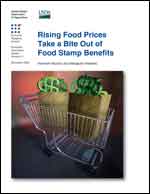Rising Food Prices Take a Bite Out of Food Stamp Benefits
- by Kenneth Hanson and Margaret Andrews
- 12/18/2008
Overview
The Food Stamp Program is designed to provide low-income families with increased food purchasing power to obtain a nutritionally adequate diet. As in most other Federal Government assistance programs, benefits are adjusted in response to rising prices-in this case, rising food prices. The current method of adjustment results in a shortfall between the maximum food stamp benefit and the cost of a nutritionally adequate diet as specified by USDA's Thrifty Food Plan. During fiscal year (FY) 2007, the shortfall in the caseload-weighted maximum benefit for the program grew from $7 in October 2006 to $19 in September 2007. In FY 2008, the amount grew from almost $8 in October 2007 to $34 in July 2008 and to $38 in September 2008. In an average month, food stamp households faced shortfalls of over $2 in FY 2003, $12 in FY 2007, and $22 in FY 2008. These losses in food purchasing power account for 1 percent, 4 percent, and 7 percent of the maximum benefit in each respective year. Alternative adjustment methods can reduce the shortfall but will raise program costs.
Download
-
Entire report
Download PDF -
Report summary
Download PDF -
Download EIB41.zip
Download ZIP -
Abstract, Contents, and Summary
Download PDF -
Introduction
Download PDF -
How the Maximum Benefit Is Adjusted for Rising Food Prices
Download PDF -
Alternative Policies for Adjusting the Maximum Benefit for Rising Food Prices
Download PDF -
Estimated Shortfall in Food Purchasing Power for All Households in the FSP Caseload
Download PDF -
Additional Federal Benefit Costs Under Alternative Adjustment Procedures
Download PDF -
Discussion
Download PDF

